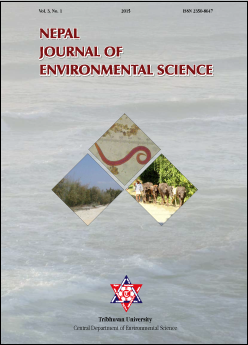Soil corrosivity to the buried-pipes used in Lalitpur, Kathmandu Valley, Nepal
DOI:
https://doi.org/10.3126/njes.v3i0.22730Keywords:
Buried-metallic pipes, Chloride, Resistivity, Soil Corrosion, SulphateAbstract
Six soil parameters (moisture content, pH, resistivity, oxidation-reduction potential, chloride and sulfate) of 23 samples were analyzed using standard methods for their corrosive nature towards the buried galvanized-steel and cast-iron pipes used to supply drinking water in three areas (Tikathali, Imadol- KA and Imadol-KHA) of Lalitpur district of Kathmandu Valley. Amounts of these six soil parameters in the collected 23 samples were found to be of 11–37% moisture content, 6.1–8.4 pH, 0.3330 x 104– 4.7620 x104 Ohm.cm resistivity, 317–553 mV (SHE) oxidation-reduction potential, 14–75 ppm chloride and 56–176 ppm sulfate contents. These findings indicated that most of soil samples collected from the study areas of Lalitpur district of Nepal are found to be mildly corrosive and less corrosive nature of soils on the buried galvanized-steel and cast-iron pipes used for the supply of drinking water. The use of non-conducting materials like gravel/sand around the buried-pipes, before burying them in the study areas seems to be effective to control such corrosion and to increase life time of the pipes.
Downloads
Downloads
Published
How to Cite
Issue
Section
License
This license enables reusers to distribute, remix, adapt, and build upon the material in any medium or format for noncommercial purposes only, and only so long as attribution is given to the creator.

